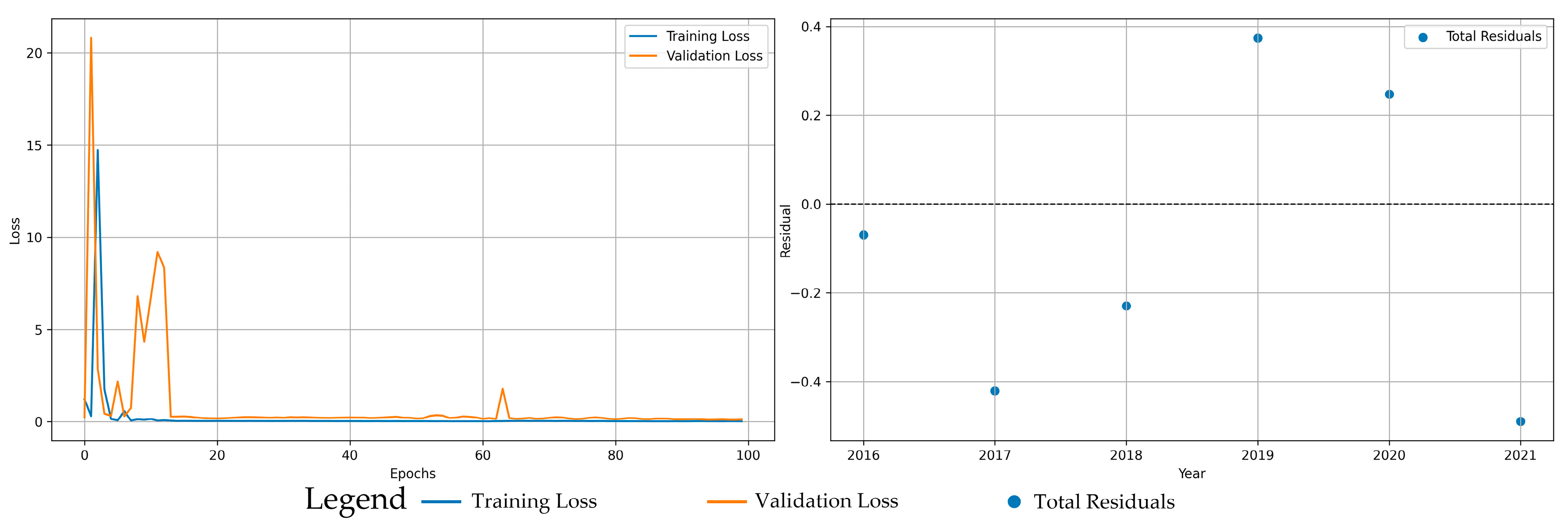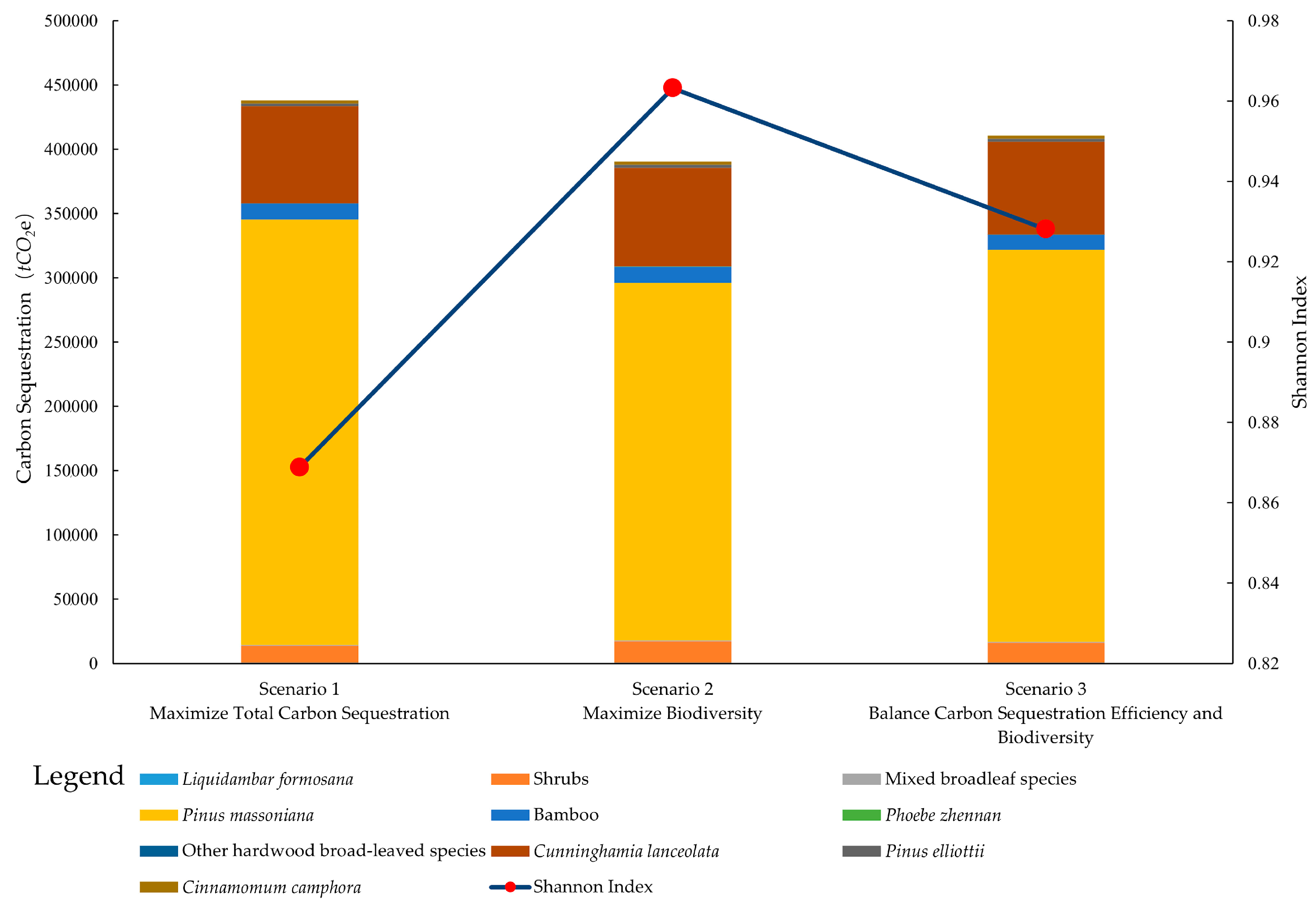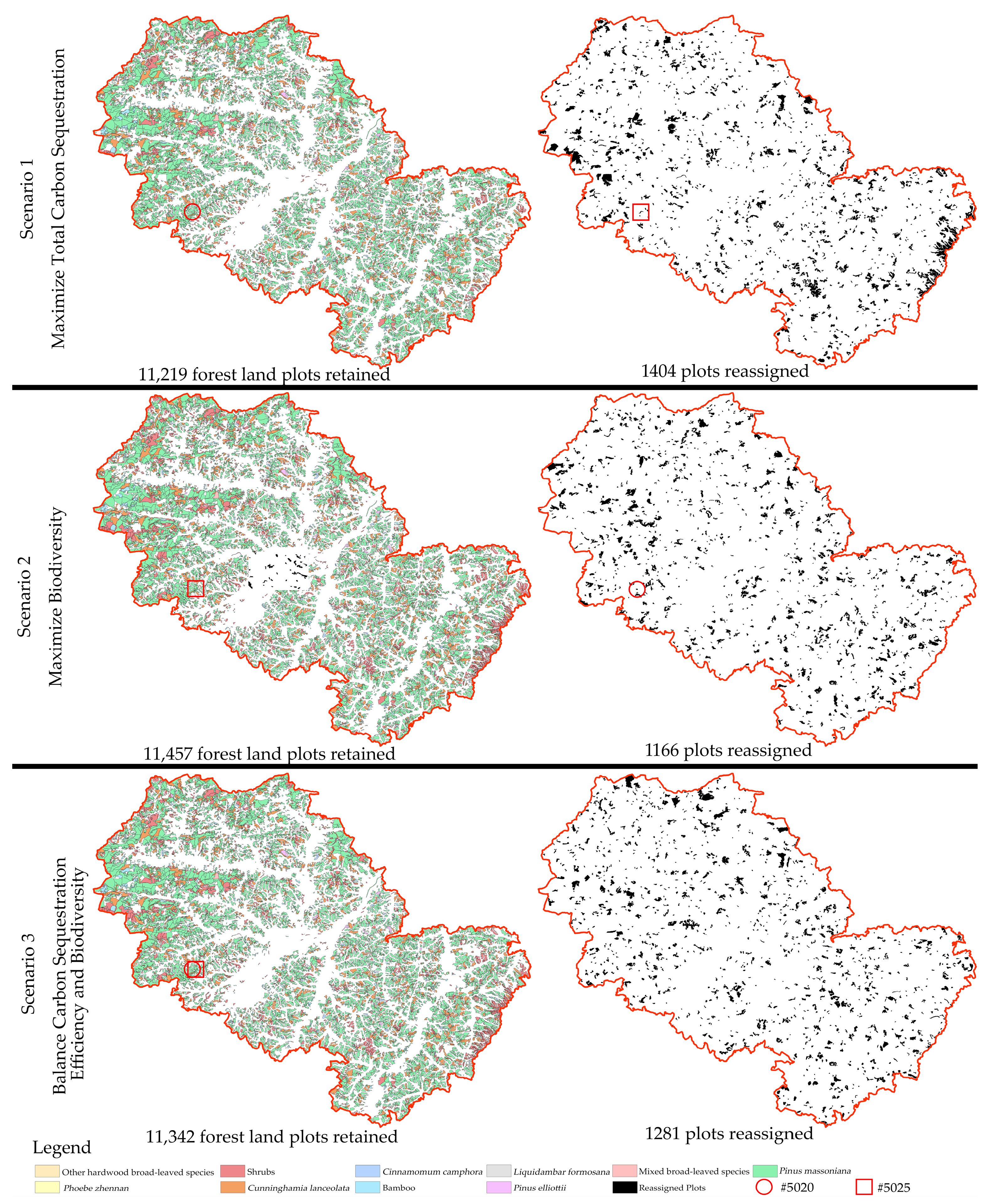Disturbance and Response Strategies of Carbon Sinks in Forest Land Due to Land Use Change: Taking Liushahe Town of Ningxiang as an Example
Abstract
1. Introduction
2. Study Area, Data, and Methods
2.1. Study Area
2.2. Data Sources
2.3. Research Framework
2.4. Research Methods
2.4.1. Land Use Structure Prediction Method
2.4.2. Growth Model Construction for Arboreal Species (Groups)
2.4.3. Carbon Sink Estimation Method
2.4.4. Diversity-Equilibrium Evaluation Method
2.4.5. Forest Land Spatial Planning Method
3. Results and Analysis
3.1. Land Use Change Trends
3.1.1. Stability of the LSTM Model
3.1.2. Land Use Evolution Trends
3.2. Carbon Sink Estimation of Forest Land Plots
3.2.1. Stability of the Growth Model for Arboreal Species (Groups)
3.2.2. Carbon Sink Assessment of Forest Land Plots
3.3. Optimization Process for Balancing “Carbon Sink Efficiency–Biodiversity Equilibrium”
3.4. Comparison of Three Forest Land Planning Scenarios
- Scenario 1: Maximization of carbon sink volume as the sole objective;
- Scenario 2: Maximization of biodiversity (Shannon index) as the sole objective;
- Scenario 3: Integration of carbon sink efficiency and biodiversity equilibrium as a multi-objective optimization strategy.
4. Discussion
4.1. Suitability of the Balanced Strategy
4.2. Integration of the Balanced Strategy with Policy Implementation
4.3. Potential Applications
4.4. Limitations and Future Improvements
5. Conclusions
Author Contributions
Funding
Data Availability Statement
Conflicts of Interest
References
- Li, Z.; Chang, J.; Li, C.; Gu, S. Ecological Restoration and Protection of National Land Space in Coal Resource-Based Cities from the Perspective of Ecological Security Pattern: A Case Study in Huaibei City, China. Land 2023, 12, 442. [Google Scholar] [CrossRef]
- Khan, K.; Khan, S.N.; Ali, A.; Khokhar, M.F.; Khan, J.A. Estimating Aboveground Biomass and Carbon Sequestration in Afforestation Areas Using Optical/SAR Data Fusion and Machine Learning. Remote Sens. 2025, 17, 934. [Google Scholar] [CrossRef]
- Zhou, X.; Wang, J.; Tang, L.; He, W.; Li, H. Impact of Land Use Change on Carbon Storage Dynamics in the Lijiang River Basin, China: A Complex Network Model Approach. Land 2025, 14, 1042. [Google Scholar] [CrossRef]
- Chen, B.; Yao, N. Evolution Characteristics of Cultivated Land Protection Policy in China Based on Smith Policy Implementation. Agriculture 2024, 14, 1194. [Google Scholar] [CrossRef]
- Li, L.; Zheng, S.; Zhao, K.; Shen, K.; Yan, X.; Zhao, Y. The Quantitative Impact of the Arable Land Protection Policy on the Landscape of Farmland Abandonment in Guangdong Province. Remote Sens. 2022, 14, 4991. [Google Scholar] [CrossRef]
- Wang, Q.; Bai, X. Spatiotemporal Characteristics and Driving Mechanisms of Land-Use Transitions and Landscape Patterns in Response to Ecological Restoration Projects: A Case Study of Mountainous Areas in Guizhou, Southwest China. Ecol. Inform. 2024, 82, 102748. [Google Scholar] [CrossRef]
- Yu, T.; Jia, S.; Dai, B.; Cui, X. Spatial Configuration and Layout Optimization of the Ecological Networks in a High-Population-Density Urban Agglomeration: A Case Study of the Central Plains Urban Agglomeration. Land 2025, 14, 768. [Google Scholar] [CrossRef]
- Li, Y.; Ma, X.; Zhao, J.; Zhang, S.; Liu, C. Spatio-Temporal Evolution and Conflict Diagnosis of Territorial Space in Mountainous–Flatland Areas from a Multi-Scale Perspective: A Case Study of the Central Yunnan Urban Agglomeration. Land 2025, 14, 703. [Google Scholar] [CrossRef]
- Zhang, J.; Ding, H.; Xu, J.; Zheng, B. A Simulation-Based Prediction of Land Use Change Impacts on Carbon Storage from a Regional Imbalance Perspective: A Case Study of Hunan Province, China. Land 2024, 13, 1721. [Google Scholar] [CrossRef]
- Liu, J.; Hu, Y.; Feng, Z.; Xiao, C. A Review of Land Use and Land Cover in Mainland Southeast Asia over Three Decades (1990–2023). Land 2025, 14, 828. [Google Scholar] [CrossRef]
- Ye, C.; Deng, P.; Ke, C.; Fu, X.; Mi, J.; Zhou, L. A Framework for Assessing the Effectiveness of Carbon Storage Change During the Process of Land Consolidation. Land 2025, 14, 747. [Google Scholar] [CrossRef]
- Yang, M.; Wang, Z.; Zhang, Z.; Chen, P.; Zhao, D.; Cheng, E.; Wang, C.; Yan, Y. Pathways for Ecological Restoration of Territorial Space Based on Ecosystem Integrity: A Case Study of Approach to Protecting and Restoring Mountains, Rivers, Forests, Farmlands, Lakes, and Grasslands in Beijing, China. Ecol. Front. 2024, 44, 1214–1223. [Google Scholar] [CrossRef]
- You, Y.; Jiang, P.; Wang, Y.; Wang, W.; Chen, D.; Hu, X. Using Multi-Scenario Analyses to Determine the Driving Factors of Land Use in Inland River Basins in Arid Northwest China. Land 2025, 14, 787. [Google Scholar] [CrossRef]
- Xu, Y.; Liu, X.; Zhao, L.; Li, H.; Zhu, P.; Liu, R.; Wang, C.; Wang, B. Spatial and Temporal Analysis of Habitat Quality in the Yellow River Basin Based on Land-Use Transition and Its Driving Forces. Land 2025, 14, 759. [Google Scholar] [CrossRef]
- Chen, N.; Nie, W.; Fan, W. Simulation and Analysis of Changes in Carbon Storage and Ecosystem Services Against the Backdrop of Land Transfer: A Case Study in Lvzenong Park. Land 2025, 14, 694. [Google Scholar] [CrossRef]
- Xie, Y.; Dai, W.; Xiang, S.; Deng, H.; Wang, Z.; Li, Y.; Wang, Z.; Zhou, M.; Gao, M. Supply and Demand of Ecosystem Services and Their Interaction with Urbanization: The Case of Chengdu-Chongqing Urban Agglomeration. Urban Clim. 2024, 55, 101978. [Google Scholar] [CrossRef]
- Peng, Y.; Cheng, W.; Xu, X.; Song, H. Analysis and Prediction of the Spatiotemporal Characteristics of Land-Use Ecological Risk and Carbon Storage in Wuhan Metropolitan Area. Ecol. Indic. 2024, 158, 111432. [Google Scholar] [CrossRef]
- Hu, X.; Dong, C.; Zhang, Y. Impacts of Cropland Utilization Patterns on the Sustainable Use Efficiency of Cropland Based on the Human–Land Perspective. Land 2024, 13, 863. [Google Scholar] [CrossRef]
- Xu, Q.; Zhu, P.; Tang, L. Agricultural Services: Another Way of Farmland Utilization and Its Effect on Agricultural Green Total Factor Productivity in China. Land 2022, 11, 1170. [Google Scholar] [CrossRef]
- Zhang, Z.; Du, J.; Shen, Z.; El Asraoui, H.; Song, M. Effects of Modern Agricultural Demonstration Zones on Cropland Utilization Efficiency: An Empirical Study Based on County Pilot. J. Environ. Manag. 2024, 349, 119530. [Google Scholar] [CrossRef]
- Ndip, F.E.; Sakurai, T. Enhancing Agricultural Intensification through Contract Farming: Evidence from Rice Production in Senegal. Agric. Food Secur. 2025, 14, 6. [Google Scholar] [CrossRef]
- Wang, Y.; Lyu, J.; Xun, L.; Chuanhua, L.; Xiaonan, M.; Jiang, L.; Qiang, L.; Lina, Z.; Guan, Q. Using Zipf’s Law to Optimize Urban Spatial Layouts in an Urban Agglomeration Area. Ann. Am. Assoc. Geogr. 2024, 114, 1342–1364. [Google Scholar] [CrossRef]
- Zhou, C.; Wu, Y. A Planning Support Tool for Layout Integral Optimization of Urban Blue–Green Infrastructure. Sustainability 2020, 12, 1613. [Google Scholar] [CrossRef]
- Luan, C.; Liu, R.; Zhang, Q.; Sun, J.; Liu, J. Multi-Objective Land Use Optimization Based on Integrated NSGA–II–PLUS Model: Comprehensive Consideration of Economic Development and Ecosystem Services Value Enhancement. J. Clean. Prod. 2024, 434, 140306. [Google Scholar] [CrossRef]
- McManamay, R.A.; Vernon, C.R.; Chen, M.; Thompson, I.; Khan, Z.; Narayan, K.B. Dynamic Urban Land Extensification Is Projected to Lead to Imbalances in the Global Land-Carbon Equilibrium. Commun. Earth Environ. 2024, 5, 70. [Google Scholar] [CrossRef]
- Zhang, Y.; Zhang, Y.; Yang, J.; Wu, W.; Tao, R. Integrating System Dynamics, Land Change Models, and Machine Learning to Simulate and Predict Ecosystem Carbon Sequestration Under RCP-SSP Scenarios: Fusing Land and Climate Changes. Land 2024, 13, 1967. [Google Scholar] [CrossRef]
- Di Lallo, G.; De Notaris, C.; Chiriacò, M.V. Evaluating Natural Climate Solutions in Long-Term Climate Strategies: Opportunities for Enhanced Mitigation Across the European Union. Land 2025, 14, 825. [Google Scholar] [CrossRef]
- Bera, D.; Chatterjee, N.D.; Dinda, S.; Ghosh, S.; Dhiman, V.; Bashir, B.; Calka, B.; Zhran, M. Assessment of Carbon Stock and Sequestration Dynamics in Response to Land Use and Land Cover Changes in a Tropical Landscape. Land 2024, 13, 1689. [Google Scholar] [CrossRef]
- Hou, L.; Hu, H.; Liu, T.; Ma, C. Ecological Security Pattern Construction for Carbon Sink Capacity Enhancement: The Case of Chengdu Metropolitan Area. Sustainability 2025, 17, 4483. [Google Scholar] [CrossRef]
- Yu, Z.; Liu, S.; Li, H.; Liang, J.; Liu, W.; Piao, S.; Tian, H.; Zhou, G.; Lu, C.; You, W.; et al. Maximizing Carbon Sequestration Potential in Chinese Forests through Optimal Management. Nat. Commun. 2024, 15, 3154. [Google Scholar] [CrossRef]
- Tao, P.; Lin, Y.; Wang, X.; Li, J.; Ma, C.; Wang, Z.; Dong, X.; Yao, P.; Shao, M. Optimization of Green Spaces in Plain Urban Areas to Enhance Carbon Sequestration. Land 2023, 12, 1218. [Google Scholar] [CrossRef]
- Song, Z.; Shi, P.; Li, P.; Li, Z.; Niu, H.; Zu, P.; Cao, M.; Jia, Y. Effects of Forest Type on Carbon Storage in the Hilly Region of Loess Plateau, China. Front. For. Glob. Change 2024, 7, 1349047. [Google Scholar] [CrossRef]
- Guan, D.; Nie, J.; Zhou, L.; Chang, Q.; Cao, J. How to Simulate Carbon Sequestration Potential of Forest Vegetation? A Forest Carbon Sequestration Model across a Typical Mountain City in China. Remote Sens. 2023, 15, 5096. [Google Scholar] [CrossRef]
- Li, M.; Li, J.; Haq, S.U.; Nadeem, M. Agriculture Land Use Transformation: A Threat to Sustainable Food Production Systems, Rural Food Security, and Farmer Well-Being? PLoS ONE 2024, 19, e0296332. [Google Scholar] [CrossRef]
- Liang, C.; Penghui, J.; Wei, C.; Manchun, L.; Liyan, W.; Yuan, G.; Yuzhe, P.; Nan, X.; Yuewei, D.; Qiuhao, H. Farmland Protection Policies and Rapid Urbanization in China: A Case Study for Changzhou City. Land Use Policy 2015, 48, 552–566. [Google Scholar] [CrossRef]
- Zhang, X.; Han, H. Characteristics and Factors Influencing the Expansion of Urban Construction Land in China. Sci. Rep. 2024, 14, 16040. [Google Scholar] [CrossRef] [PubMed]
- Bai, J.; Jia, Z.; Sun, Y.; Zheng, C.; Wen, M. Multi-Scenario Simulation of Land Use Change Along with Ecosystem Service Value for the Lanzhou–Xining Urban Agglomeration. Land 2025, 14, 860. [Google Scholar] [CrossRef]
- Wang, L.; Wei, F.; Tagesson, T.; Fang, Z.; Svenning, J.-C. Transforming Forest Management through Rewilding: Enhancing Biodiversity, Resilience, and Biosphere Sustainability under Global Change. One Earth 2025, 8, 101195. [Google Scholar] [CrossRef]
- Viljur, M.-L.; Abella, S.R.; Adámek, M.; Alencar, J.B.R.; Barber, N.A.; Beudert, B.; Burkle, L.A.; Cagnolo, L.; Campos, B.R.; Chao, A.; et al. The Effect of Natural Disturbances on Forest Biodiversity: An Ecological Synthesis. Biol. Rev. 2022, 97, 1930–1947. [Google Scholar] [CrossRef]
- TD/T 1055-2019; Technical Regulation of the Third Nationwide Land Survey. Standards Press of China: Beijing, China, 2019.
- Zhao, X.; Wang, P.; Gao, S.; Yasir, M.; Islam, Q.U. Combining LSTM and PLUS Models to Predict Future Urban Land Use and Land Cover Change: A Case in Dongying City, China. Remote Sens. 2023, 15, 2370. [Google Scholar] [CrossRef]
- Ruehr, S.; Keenan, T.F.; Williams, C.; Zhou, Y.; Lu, X.; Bastos, A.; Canadell, J.G.; Prentice, I.C.; Sitch, S.; Terrer, C. Evidence and Attribution of the Enhanced Land Carbon Sink. Nat. Rev. Earth Environ. 2023, 4, 518–534. [Google Scholar] [CrossRef]
- Tadese, S.; Soromessa, T.; Aneseye, A.B.; Gebeyehu, G.; Noszczyk, T.; Kindu, M. The Impact of Land Cover Change on the Carbon Stock of Moist Afromontane Forests in the Majang Forest Biosphere Reserve. Carbon. Balance Manag. 2023, 18, 24. [Google Scholar] [CrossRef] [PubMed]
- Cheng, H.; Wang, Y.; Shan, L.; Chen, Y.; Yu, K.; Liu, J. Mapping Fine-Scale Carbon Sequestration Benefits and Landscape Spatial Drivers of Urban Parks Using High-Resolution UAV Data. J. Environ. Manag. 2024, 370, 122319. [Google Scholar] [CrossRef]
- García, J.C.C.; Arango, A.M.A.; Trinh, L. The Potential of Bamboo Forests as a Carbon Sink and Allometric Equations for Estimating Their Aboveground Biomass. Environ. Dev. Sustain. 2024, 26, 20159–20187. [Google Scholar] [CrossRef]
- Li, L.; Zayiti, A.; He, X. Evaluating the Stand Structure, Carbon Sequestration, Oxygen Release Function, and Carbon Sink Value of Three Artificial Shrubs alongside the Tarim Desert Highway. Forests 2023, 14, 2137. [Google Scholar] [CrossRef]
- Nadirgil, O. Carbon Price Prediction Using Multiple Hybrid Machine Learning Models Optimized by Genetic Algorithm. J. Environ. Manag. 2023, 342, 118061. [Google Scholar] [CrossRef]
- Ceni, A. Random Orthogonal Additive Filters: A Solution to the Vanishing/Exploding Gradient of Deep Neural Networks. IEEE Trans. Neural Netw. Learn. Syst. 2025, 36, 1–14. [Google Scholar] [CrossRef]
- Yao, J.; Zhao, C.; Hu, X.; Jin, Y.; Li, Y.; Cai, L.; Li, Z.; Li, F.; Liang, F. A Method for Estimating Tree Growth Potential with Back Propagation Neural Network. Sustainability 2025, 17, 1411. [Google Scholar] [CrossRef]
- Guo, W.; Liu, Z.; Xu, W.; Wang, W.J.; Shafron, E.; Lv, Q.; Li, K.; Zhou, S.; Guan, R.; Yang, J. Spatial and Temporal Patterns of Forest Biomass Carbon Sink in China from 1990 to 2021. Remote Sens. 2024, 16, 3811. [Google Scholar] [CrossRef]
- Kitikidou, K.; Milios, E.; Stampoulidis, A.; Pipinis, E.; Radoglou, K. Using Biodiversity Indices Effectively: Considerations for Forest Management. Ecologies 2024, 5, 42–51. [Google Scholar] [CrossRef]
- Papazoglou, G.; Biskas, P. Review and Comparison of Genetic Algorithm and Particle Swarm Optimization in the Optimal Power Flow Problem. Energies 2023, 16, 1152. [Google Scholar] [CrossRef]
- Xiao, Y.; Zhao, J.; Zhang, Y.; Wang, S. Grain Self-Sufficiency in Guangdong, China: Current Trends and Future Perspectives. Foods 2025, 14, 1126. [Google Scholar] [CrossRef] [PubMed]
- Wang, C.; Li, M.; Wang, X.; Deng, M.; Wu, Y.; Hong, W. Spatio-Temporal Dynamics of Carbon Storage in Rapidly Urbanizing Shenzhen, China: Insights and Predictions. Land 2024, 13, 1566. [Google Scholar] [CrossRef]
- Wang, Z.; Xu, L.; Shi, Y.; Ma, Q.; Wu, Y.; Lu, Z.; Mao, L.; Pang, E.; Zhang, Q. Impact of Land Use Change on Vegetation Carbon Storage During Rapid Urbanization: A Case Study of Hangzhou, China. Chin. Geogr. Sci. 2021, 31, 209–222. [Google Scholar] [CrossRef]
- Han, B.; Jin, X.; Zhao, Q.; Chen, H. Spatiotemporal Patterns and Mechanisms of Land-Use Conflicts Affecting High-Quality Development in China. Appl. Geogr. 2023, 155, 102972. [Google Scholar] [CrossRef]









| Ecological Factor | Type | Encoding Method |
|---|---|---|
| Growth Stage | Young Forest (Young Bamboo), Middle-Aged Forest (Mature Bamboo), Pre-Mature Forest (Old Bamboo), Mature Forest, Over-Mature Forest | 1–5 |
| Plot Area | Actual measured values were normalized to a scale of 1 to 10 for modeling purposes. | |
| Landform | Very High Mountain, High Mountain, Medium Mountain, Low Mountain, Hill, Plain | 1–6 |
| Slope Aspect | North, Northeast, East, Southeast, South, Southwest, West, Northwest, No Slope Aspect | 1–9 |
| Slope Position | Ridge, Upper Slope, Middle Slope, Lower Slope, Valley, Flat Land, Entire Slope | 1–7 |
| Slope Gradient | Flat, Gentle, Moderate, Steep, Very Steep, Extremely Steep | 1–6 |
| Soil Type | Red Soil, Paddy Soil | 1–2 |
| Soil Thickness | Actual measured values were normalized to a scale of 1 to 10 for modeling purposes. | |
| Origin | Natural, Purely Natural, Artificially Promoted, Naturally Regenerated | 1–1.3 |
| Artificial, Planting (Seedlings), Direct Seeding, Aerial Seeding, Coppice Regeneration (Artificial) | 2–2.4 | |
| Planting Density | Actual measured values were normalized to a scale of 1 to 10 for modeling purposes. |
| Variable | VIF | Tolerance |
|---|---|---|
| Growth Stage | 2.996 | 0.334 |
| Plot Area | 1.210 | 0.826 |
| Landform | 1.267 | 0.789 |
| Slope Aspect | 1.092 | 0.916 |
| Slope Position | 1.070 | 0.934 |
| Slope Gradient | 1.053 | 0.950 |
| Soil Type | 1.019 | 0.982 |
| Soil Thickness | 1.060 | 0.943 |
| Origin | 1.006 | 0.994 |
| Planting Density | 3.091 | 0.324 |
Disclaimer/Publisher’s Note: The statements, opinions and data contained in all publications are solely those of the individual author(s) and contributor(s) and not of MDPI and/or the editor(s). MDPI and/or the editor(s) disclaim responsibility for any injury to people or property resulting from any ideas, methods, instructions or products referred to in the content. |
© 2025 by the authors. Licensee MDPI, Basel, Switzerland. This article is an open access article distributed under the terms and conditions of the Creative Commons Attribution (CC BY) license (https://creativecommons.org/licenses/by/4.0/).
Share and Cite
Zou, Y.; Xu, F.; Chen, Y. Disturbance and Response Strategies of Carbon Sinks in Forest Land Due to Land Use Change: Taking Liushahe Town of Ningxiang as an Example. Land 2025, 14, 1418. https://doi.org/10.3390/land14071418
Zou Y, Xu F, Chen Y. Disturbance and Response Strategies of Carbon Sinks in Forest Land Due to Land Use Change: Taking Liushahe Town of Ningxiang as an Example. Land. 2025; 14(7):1418. https://doi.org/10.3390/land14071418
Chicago/Turabian StyleZou, Yu, Feng Xu, and Yingrui Chen. 2025. "Disturbance and Response Strategies of Carbon Sinks in Forest Land Due to Land Use Change: Taking Liushahe Town of Ningxiang as an Example" Land 14, no. 7: 1418. https://doi.org/10.3390/land14071418
APA StyleZou, Y., Xu, F., & Chen, Y. (2025). Disturbance and Response Strategies of Carbon Sinks in Forest Land Due to Land Use Change: Taking Liushahe Town of Ningxiang as an Example. Land, 14(7), 1418. https://doi.org/10.3390/land14071418





